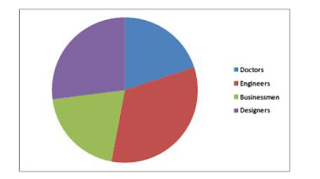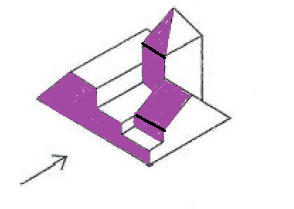Q 1 . A 12 cm x 12 cm x 12 cm wooden cube is painted and its four views are shown below. this cube is sliced into 64 smaller equal sized cubes of 3 cm x 3 cm x 3 cm. How many of these small cubes will have exactly one green face and exactly one orange face in the same cube ?


Ans.
From fig we can say that the cube has 3 orange and three green surfaces and if it is sliced into 64 smaller equal sized cubes of 3 cm x 3 cm x 3 cm.Then we have
1) corner 1to 8 cubes will have three colours.
2) center abcd and like wise will have single colour.
3) hatched cubes will have one orange and one green face.( other 3 faces ,hidden, are green )
so we get 12 as ans.
Q 2 The following fig.is cloned and the cloned fig.is reflected along the xy axis .how many rectangles are present in the resultant fig.?
Ans
1)first count rectangles in original fig as shown in A . there are eight rectangles.
2) after cloning and reflection similar eight rectangles are there.(total 16).
3) considering fig. together as in B there are nine rectangles.(see colour wise to understand)
4)total 16+9 =25 rectangles.
Q 3 Shown below are pieces of a regular polygon how many sides the polygon have?
Ans 3
Just count the vertex and the ans will be 7 .
Q4 How many different types of characters appear in the figure given below?
Ans 4
28 different types of characters are there in the figure.
Q5 How many fonts are used in the given sets of words?
Ans 5
there are 11 fonts as shown.
observe the common letters,curves ,lines, angle at end of lines .
Bold and normal letters can be of same font.
Q 6 A shopkeeper is offering discounts for the festive season.The discount is based on a series.The following table depicts the first five combination of this series.The purchase amount and discount are in rupees.How much is the discount for a purchase of rupees 75,000?
Ans If we observe the chart we find that
Difference between discount of first two combination is 30.
Difference between discount of second and third is 60.
Difference between discount of third and fourth is 120.
Difference between discount of fourth and fifth is 240.
i.e. in next combination discount is getting doubled . (purchase amount also getting doubled)
our next combination in series will be
purchase Discount
>_4801 and < 9601 949 (difference of 480 from 5 term)
>_ 9601 and <19201 1909 ( difference of 960 from 6 term)
>_ 19201 and < 38401 3829 (difference of 1920 from 7 term)
>_ 38401 and <76801 7669 (difference of 3840 from 8 term)
7669 is the ans.
Q 7 Given the following equation, how many parrots are equal to one elephant?
Ans.
given that
1 parrot + 2 fish = 4 elephants ....................(1)
2 parrots + 1 elephant = 1 fish + 1 parrot ...................(2)
solution
from eq (2) we can say that 1 parrot + 1 elephant = 1 fish
substituting in eq. (1)
1 parrot + 2( 1 parrot + 1 elephant) = 4 elephants
1 parrot + 2 parrot + 2 elephants = 4 elephants
3 parrots = 2 elephants
3/2 parrots = 1 elephant
ans is 1.5
Q 8 how many of the alphabets using the font shown below when flipped on the horizontal axis,can still be read as capital alphabets in the same font?
Ans.
Alphabets when flipped on the horizontal axis and still can be read as capital alphabets in the same font are
B C D E H I K M O W X ( M canbe read as W and W as M) ans is 11
Q 9 shown below in figure 1 is a layout of a chess board with one knight and several pawns. Given that the knight cannot land on any square that has pawn,but can jump over it ,the pawns cannot move,and the knight moves on a chess board as shown in fig.2, what is the least number of steps required for the knight to reach square x ?
ans
Knight takes 8 steps to reach square X
Q 10 Shown below is a fan with red coloured patterns on it .when it rotates , the patterns make circles.How many red circles will be seen when the fan rotates?
ans
There will be 8 red circles as shown in fig. (some lines coincides) zigzag lines will not make circle.
Q11 Fig 1 has been constructed by overlapping some alphabets .Assuming the alphabets may be rotated, how many alphabets from fig 2 cannot be overlapped to fit within fig.1?
Ans first find out the overlapped alphabets they are B ,C (ROTATED) ,D,E,F,G (ROTATED)H,L,P,
total 9 ,
so remaining 17 alphabets cannot be overlapped to fit within fig 1.
(alphabets J,K,R may create confusion but their curve,inclined lines are different.)
Q12 Two gearsA and B with red arrows are shown below. Gear A rotates in clockwise direction.How many complete rotations does the gear B have to make for the red arrows to meet?
Ans
For red arrows of Gear A and Gear B to meet,
Arrow of A should be at 4 and B to be at B1 (see fig above)
When Gear B rotates full 1 time Gear A position will be 7, like wise
2 times Gear A position will be 3
3 times Gear A position will be 10
4 times Gear A position will be 6
5 times Gear A position will be 2
6 times Gear A position will be 9
7 times Gear A position will be 5
8 times Gear A position will be 1
9 times Gear A position will be 8
10 times Gear A position will be 4 ( required)
Gear B will make 10 complete rotation .
(It can be solved by gear ratio method )
Q13 Fig. 1 is an image composed of partial circles.Some cuts in the circle form the corners of triangles as shown in fig 2 What is the total number of triangles whose three corners are formed by three circles?
Ans
10 triangles are formed as shown by red .
Q 14 There are two discs, one with numbers and other with three cut outs as shown in fig 1 and are overlapped as shown in fig 2.For every second,the numbered disc rotates two numbers in anticlockwise direction and the cut out disc rotates one number in the clockwise direction.If the arrangement at zero second is as shown in fig 2, what will be the number inside the pentagonal cut out at 5 seconds?
Ans If the numbered disc rotates two number in anticlockwise direction the the position of numbered disc will remain same.
If the cut out disc rotates one number in the clockwise direction the pentagonal cut out will be at 3.
so ans is 3.
Q 15 Fig. 1 is formed by a black square inscribed in a white circle which in turn is inscribed in another black square of side 2 cm as shown. If a point is chosen at random inside fig.1, what is the probability that the point will be in the area shaded black?
Ans. first find the area of black region
area of outer square = 2 x 2 =4 sq cm
area of circle = pie r x r = 3.14 x 1 ( diameter is 2 cm )
area of corner black region will be =outer square- circle = 4 - 3.14 = 0.86 sq.cm
In inner square Diagonal is 2 cm ( diameter of circle )
From Pythagoras theorem we can find sides
2 x 2 = (side x side) + (side x side)
2 x 2 = 2 (side x side )
side = 1.41
so area of black inner square = 1.41 x 1.41 = 1.98
Total black region = 0.86 + 1.98 = 2.84
probability that the point will be in the area shaded black= area of black region / total area
p = 2.84 / 4 = 0.71 Ans
Q 16
Q 17 Shown below are two views of the same 3D object . How many non contiguous surfaces are there in the object ?
Ans
There are 36 surfaces as shown in fig. ( second top is one surface)
Q 18
Q 19 A 3 x 3 grid as shown in fig 1 is to be filled with numbers 1 to 9 according to the following rules :
- 8 is above 9 and to the right of 2
- 3 is to the right of 7 and above 9 which is to the left of 4
- 2 is to the left of 5
-7 is above 6 and 2
-1 is above 5
'To the left of ' or 'to the right of' means in the same row
Above or below means in the same column
What is the sum of the three numbers in the middle row?
Ans From above rules we find the grid as shown
and the sum of the three numbers in the middle row = 15























































